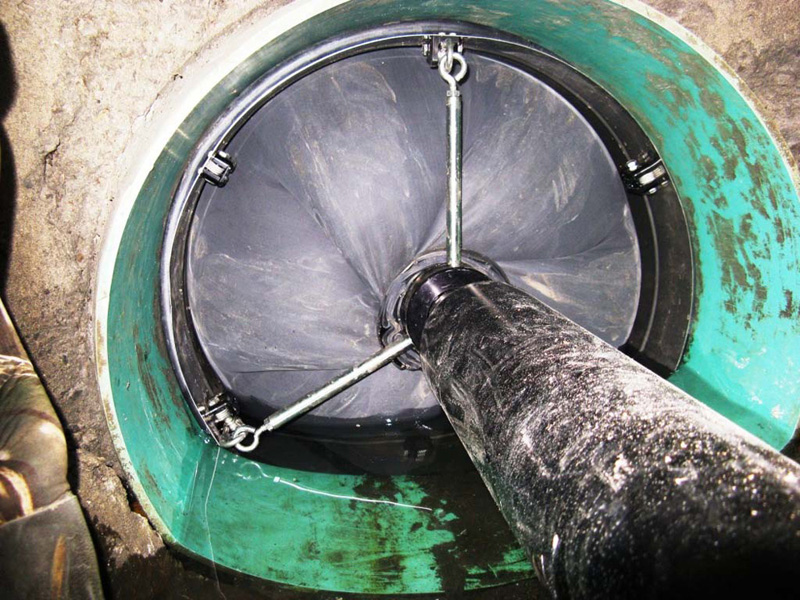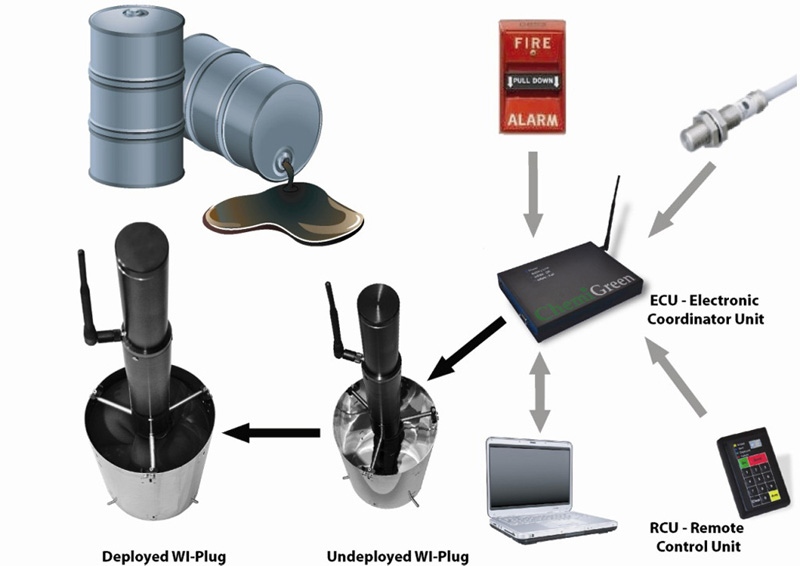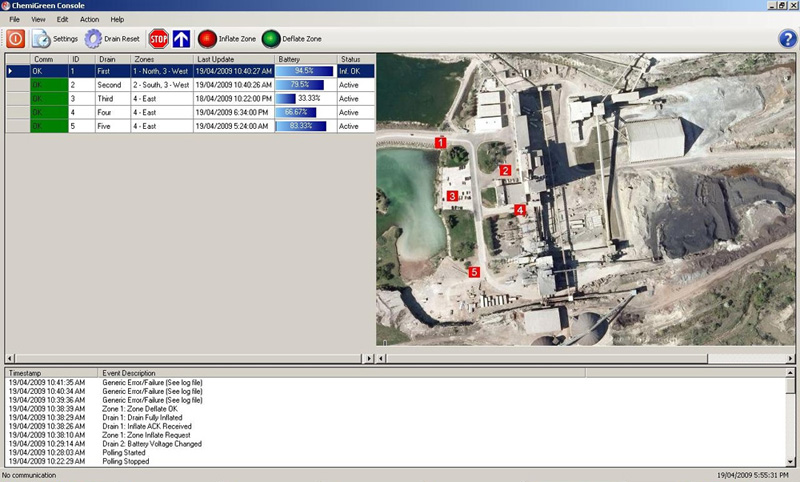Chemical spills are regrettably, still one of the most neglected issues within the clean technology marketplace. These spills occur throughout industry on a daily basis. With the US National Response Center reporting over 37,000 spills in 2008 and Environment Canada reporting over 10,000 spills annually it is apparent that there is a need for something more than a band aid solution. Spilled chemical will always flow to the lowest point in the facility – "the drain. If it is not stopped at this unprotected point, any control of the spill is lost and the damage done! Chemical spills not only create irreversible environmental damage, but also substantially tarnish the violators' reputation and carry extremely high monetary costs. In recent years, environmental agencies have stiffened their penalties and increased their enforcement efforts in order to mitigate the damage that these ongoing chemical spills are causing to the environment. The trend towards a greener and cleaner industry and greater environmental responsibility suggests that companies can no longer afford to neglect their chemical spill reaction plan. Surprisingly, despite the high frequency of chemical spills and their harsh environmental impact, until now there hasn't been a complete solution in the market for large industrial spills. The most commonly used spill control devices include: absorbent pads and sands or rubber mats that are manually deployed. All of these manual devices carry a symbolic value at best when a large spill occurs and often put employees reacting to the spill at greater risk. Reviewing historical chemical spill containment results will show that most large chemical spills are not contained effectively and large amounts are often released into the environment. Although almost every spill can be handled with the proper training and equipment within a few hours, this current standard is simply not good enough. To be effective, a solution must contain the chemical spill within seconds from detection, preferably by an employee with very little training and from a safe distance. Chemical spill containment procedures have been lagging years behind advancements in automation and computerization. Recently, ChemiGreen Inc. introduced an innovative system to the market that fills this void: A wireless spill containment system, the WI-Plug. This patented WI-Plug system has been installed in a number of facilities in southern Ontario and Quebec. It has been thoroughly tested and proven effective in its application. WI-Plug: The WI-Plug can be installed with no change of infrastructure in any location regardless of pipe size (up to 30"), orientation or location. It can be installed in horizontal or vertical pipes and can be installed underground at any depth. The installation is non- invasive and requires no flanges, pipe cutting or changes of infrastructure. Installation is easy and generally takes under one hour. The WI-Plug can be tailored to an assortment of chemicals. The intelligent WI-Plug system will report to the user, via email, if the system requires maintenance or battery change. It will also report on the success or failure of the plug deployment. Figure 2 depicts a deployed plug in a 21" pipe. The plug was activated from the control room 150' away during an actual spill (water simulation). |
The WI-Plug system is an incident command and spill control system and its sole function is keeping spills on site. The system commander can monitor effluents, detect and contain spills. The commander signals the WI-PLUG to block the discharge from entering the drainage system. The WI-Plug immediately deploys, and contains the spill, while the commander transmits the alarm to the plant's Control Centre. Simultaneously, key-personnel are notified of the incident by e-mails. By removing the time constraints, the system transforms this emergency situation into a routine and safe clean-up. In addition, the system requires no infrastructure. Therefore,it is not only efficient and flexible, but it is also economically sound. Due to the fact that the WI plug substantially reduces the environmental risk involved in chemical spills, it is likely to reduce the costs of training personnel as well as insurance costs.
Figure 1 displays the WI-plug's system layout; the system commander is placed in the centre, and controls the entire system operation. It is the central processing unit of the WI-Plug system and it can activate up to 128 plugs simultaneously. The commander receives an activation signal wirelessly, from one of the system's sources such as remote control unit (RCU), sensors, alarm system and a computer. Each WI-Plug can be controlled individually or as a group. The commander is located in an office or control room; it can be connected to a PC or network which allows easy access to the system for quick activation or for the system's management. The commander can also be connected to any alarm or sensor system to enable automatic activation when a sensor detects chemicals in the effluent or in the case of a fire alarm. The commander uses an encrypted wireless mesh network that uses three levels of encryption for security. The system employs a mesh network which is extremely robust and is designed for industrial use. The commander will continue normal operation even during a power outage (up to 48 hours). |
The easy to use handheld Remote Control Unit (RCU) enables the activation of any WI-Plug from any location in the facility using a few key strokes. Deployment is completed within seconds and the RCU receives real time status reports of the success / failure of the deployment. The RCU enables personnel to contain a spill and alert the Emergency Response Team (ERT) simultaneously. A remote control unit can be placed at any location with a spill risk, in order to enable spill containment within seconds from detection. The system management PC software allows connection to the commander from any desktop or laptop computer for system monitoring and configuration. The software also sends email notifications on warnings, errors, and deployments. The WI-Plug system can work autonomously without a PC connection during power-outs. A snap shot of the software is depicted at Figure 3. |
 Figure 2- WI-Plug deployed within a 21" pipe |
|
|
When a spill occurs the ERT usually has three main missions. The first is to stop the spill at its source in order to minimize the amount of chemical being spilled. The second is linked to the first and is to fix the equipment and return the production line to normal as soon as possible. The third is to prevent the chemical from entering the drainage system. When spills happen during the night shift, finding enough people to handle all jobs can be hard. With a system like the WI-Plug installed, the third critical mission is covered in seconds by simply pressing a button; this will lead to better results with regard to both the environmental protection and in getting the production back online. Plant engineers and environmental officers should now change the type of training and equipment that their personnel need for emergency responses. The plant can be re analyzed for spill risks, and all high risk drains should be protected by wireless plugs. In addition to chemical spills, the system can also solve another aching problem - fire fighting water. According to the Ontario fire code, the fire water used by fire fighters during industrial fires is considered a chemical. By connecting the WI-Plug system to the fire alarm it can be automatically deployed and prevent the contaminated fire water from leaving the facility. |
These new safety measures give companies leverage when negotiating their pollution insurance premiums. As in home insurance, when measures to protect the home are installed , the insurance premium is reduced,, the reduced risk of chemical spills and its damage should affect the cost of insuring the facility. Given these reduced insurance costs, most facilities would be able to offset the installation costs of the WI-Plug within the first year or two. To summarize, the WI-Plug system is now a reality and ChemiGreen's vision is changing the industry's approach and standards regarding chemical spills now, any facility can have the ability to contain even the largest spill with a press of a button without leaving the office or the control room. Installing the WI-Plug will not only reduce the environmental risk, but it is also an economically sound solution. It requires no additional investment in infrastructure, it will prevent potential cleaning costs, enable faster recovery time to normal operation, reduce insurance costs and most important- it will protect against potential damage to company's reputation. We have all read and heard about green and clean technology, but now it's available for your facility to make a measurable difference. By Environmental Science & Engineering Magazine |

